
The Kingdom of Croatia entered a personal union with the Kingdom of Hungary in 1102, after a period of rule of kings from the Trpimirović and Svetoslavić dynasties and a succession crisis following the death of king Demetrius Zvonimir. With the coronation of King Coloman of Hungary as "King of Croatia and Dalmatia" in 1102 in Biograd, the realm passed to the Árpád dynasty until 1301, when the (male) line of the dynasty died out. Then, kings from the Capetian House of Anjou, who were also cognatic descendants of the Árpád kings, ruled the kingdoms. Later centuries were characterized by conflicts with the Mongols, who sacked Zagreb in 1242, competition with Venice for control over Dalmatian coastal cities, and internal warfare among Croatian nobility. Various individuals emerged during the period, such as Paul I Šubić of Bribir, who was representing the most powerful Croatian dynasty at the time, the Šubić noble family. These powerful individuals were on occasion able to de facto secure great deal of independence for their fiefdoms. The Ottoman incursion into Europe in the 16th century significantly reduced Croatian territories and left the country weak and divided. After the death of Louis II in 1526 during the Battle of Mohács and a brief period of dynastic dispute, both crowns passed to the Austrian House of Habsburg, and the realms became part of the Habsburg monarchy.

The Battle of Sisak was fought on 22 June 1593 between Ottoman Bosnian forces and a combined Christian army from the Habsburg lands, mainly Kingdom of Croatia and Inner Austria. The battle took place at Sisak, central Croatia, at the confluence of the Sava and Kupa rivers, on the borderland between Christian Europe and the Ottoman Empire.
The military history of Croatia encompasses wars, battles and all military actions fought on the territory of modern Croatia and the military history of the Croat people regardless of political geography.

The Battle of Krbava Field was fought between the Ottoman Empire of Bayezid II and an army of the Kingdom of Croatia, at the time in personal union with the Kingdom of Hungary, on 9 September 1493, in the Krbava field, a part of the Lika region in Croatia.
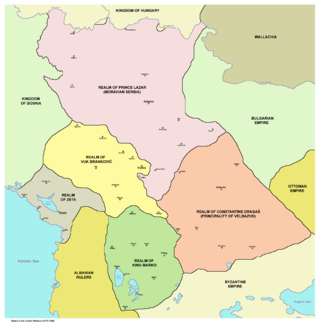
The Battle of Pločnik was fought sometime between 1385 and 1387 near the village of Pločnik, between the forces of Serbian Prince Lazar Hrebeljanović, and the invading Ottoman Army of Sultan Murad I.

Hasan Predojević, also known as Telli Hasan Pasha, was the fifth Ottoman beylerbey (vali) of Bosnia and a notable Ottoman Bosnian military commander, who led an invasion of the Habsburg Kingdom of Croatia during the Ottoman wars in Europe. From July to October 1592, Hasan-paša Predojević led devastating raids into Slavonia, Bohemia, Croatia, and Hungary resulting in the capture of 35,000 people and the enslavement and death of more than 20,000 people.

The Hundred Years' Croatian–Ottoman War was a sequence of conflicts, mostly of relatively low intensity, between the Ottoman Empire and the medieval Kingdom of Croatia, and the later Habsburg Kingdom of Croatia. Besides periods of small-scale borderland warfare, the conflict also saw episodes of major conquest campaigns of Croatian land undertaken by the Ottomans especially during the 16th century.
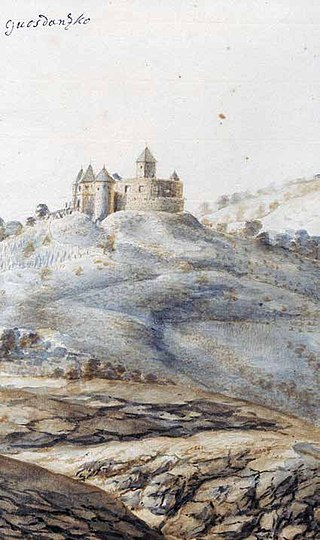
The siege of Gvozdansko was an Ottoman siege of the fort of Gvozdansko in the Kingdom of Croatia in 1577–1578. In the 1570s, the Ottomans intensified their efforts to capture the valley of the Una River. A string of forts along the Una, centred around Gvozdansko and in possession of the Zrinski noble family, formed the main line of defense of Croatia since 1527. The fort held off Ottoman attacks in 1540 and 1561.

Christoph Frankopan was a Croatian count from the noble House of Frankopan. He was born in a dangerous time, which included the fall of Bosnia to the Ottoman Empire and the start of the Hundred Years' Croatian-Ottoman War. As a supporter of King John I of Hungary during the succession crisis between János Zápolya and Ferdinand Habsburg, he was named the ban of Croatia in 1526, and died the following year while leading an army financed by Zápolya.

The Battle of Slunj was fought on 26 October 1584 between the Ottoman forces of the Bosnian Beglerbeg, Ferhad Pasha Sokolović, and Germanic and Croatian forces led by Jobst Joseph von Thurn and Tamás Erdődy, the Ban of Croatia, that ambushed the Ottoman Army stationed near the town of Slunj. The battle was a part of the Croatian–Ottoman wars and Ottoman–Habsburg wars between the Ottoman Empire and the Habsburg monarchy. Ottoman troops were estimated at between 8-10,000 men, and the army of Thurn and Erdödy consisted of 1,330 cavalry and 700 infantry. The battle resulted in a crushing defeat for the Ottoman forces.

The Battle of Una was fought on 29 and 30 October 1483 between the regional Ottoman forces, mostly from the Sanjak of Bosnia, and the Kingdom of Croatia near Brod Zrinski at the Una River crossing and was one of the first major Croatian victories against the Ottoman Empire. The Croatian army was led by the Ban of Croatia Matthias Geréb and several members of the House of Frankopan, joined by other Croatian nobles and the Despot of Serbia, Vuk Grgurević. Their goal was to intercept the Ottomans that were moving towards the Una River. In the battle that lasted for 2 days the Ottomans were defeated and soon a 7-year truce was signed with Sultan Bayezid II.
The Battle of Dubica was fought on 16 August 1513 between the Kingdom of Croatia and the Ottoman Empire. The Croatian army was commanded by Petar Berislavić, Ban of Croatia, while the Ottoman army was mostly composed of forces from the Sanjak of Bosnia under the command of Sanjak-bey Junuz-aga. The two armies clashed near the town of Dubica in central Croatia, between the Sava and Una rivers. The battle resulted in a Croatian victory and heavy losses for the Ottoman side.
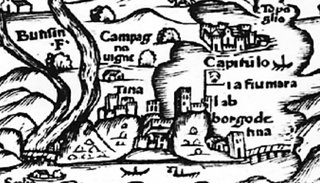
The siege of Knin was a siege of the city of Knin, the capital of the Kingdom of Croatia, by the Ottoman Empire in 1522. After two failed attempts in 1513 and 1514, Ottoman forces led by Ghazi Husrev Bey, sanjak-bey (governor) of the Sanjak of Bosnia, launched a major offensive on southern Croatia in the spring of 1522. In May, his forces, reinforced with troops from the Sanjak of Herzegovina and Constantinople, besieged the Knin Fortress.
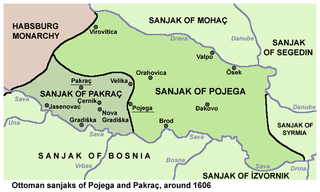
The Sanjak of Pakrac or Sanjak of Čazma or Sanjak of Cernica was one of the sanjaks of the Ottoman Empire whose capital was first Zaçasna and then Pakrac and Cernik in Ottoman Slavonia. It was established after the Ottomans captured Slavonia in the mid 16th century.
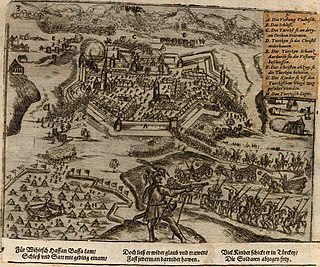
The siege of Bihać was the besieging and capture of the city of Bihać, Kingdom of Croatia within Habsburg monarchy, by the Ottoman Empire in June 1592. With the arrival of Hasan-paša Predojević as the Beylerbey of the Bosnia Eyalet in 1591, a period of peace established between Emperor Rudolf II and Sultan Murad III ended and the provincial Ottoman armies launched an offensive on Croatia. Bihać, a nearly isolated city on the Una River that repelled an Ottoman attack in 1585, was one of the first targets. Thomas Erdődy, the Ban of Croatia, used available resources and soldiers to protect the border towns, but the Ottomans managed to take several smaller forts in 1591. As the offensive gained pace, the Croatian Parliament passed a law on a general uprising in the country on 5 January 1592.
Skrad (pronounced[skraːd] is a medieval ruined castle located on the right bank of the Korana river in modern Karlovac County, Croatia. It overlooks the river gorge from a small hill at the end of a larger hill, whose height above sea level is 430 m. It is roughly triangular in plan, and once included 6 towers, a church, and a number buildings, though today very little rises above grass-level. It was one of the larger castles in the region, though not quite as large as Modruše or Cetin.

The Battle of Jajce took place in January 1518 during a series of wars between the Ottoman forces of Husrev Beg, Beylerbey of the Bosnia Eyalet, and the Hungarian and Croatian forces led by Croatian Ban Petar Berislavić. The battle was a part of the Croatian–Ottoman wars and Ottoman–Hungarian wars.
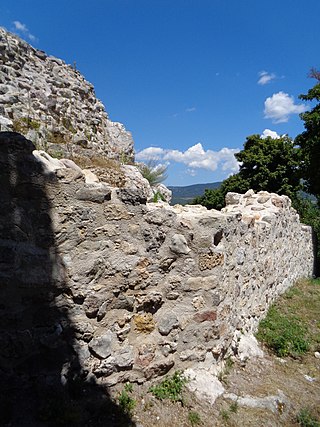
Udbina Castle is a ruined medieval fortified structure in the town of Udbina, Lika-Senj County, Croatia. Built on the top of a hill at the northern end of the town, it overlooks a large part of the Krbava field, just above the place where the fierce and bloody Battle of Krbava between the army of the Kingdom of Croatia and the Ottoman Empire was fought in 1493. Once property of the powerful Kurjaković noble family, the castle was captured by the Ottomans in 1527. It was recaptured in 1689 by Habsburg-Croatian army, but later, by the end of the 19th century, uncared-for, the castle slowly turned into a ruin.
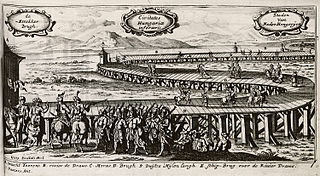
The Great Turkish War of 1684–1689 saw conflict between the Holy League and the Ottoman Empire in territories of Croatia, Slavonia and Dalmatia. The war was concluded by the Treaty of Karlowitz in 1699, which significantly eased the Ottoman grip on Croatia.

The siege of Sokolac was a siege of Sokolac Castle in Brinje, Kingdom of Croatia, in August 1493, by the joint bans of Croatia John Both de Bajna and Emerik Derenčin, against the Frankopan family, due to the Frankopans' attempt to regain control over the town of Senj. John Both was killed during the siege, and it was eventually abandoned after Derenčin received news of an approaching Ottoman army. The two sides made truce, and fought the Ottomans together at the Battle of Krbava Field the following month.




















